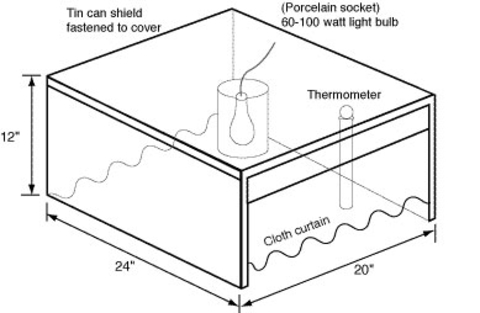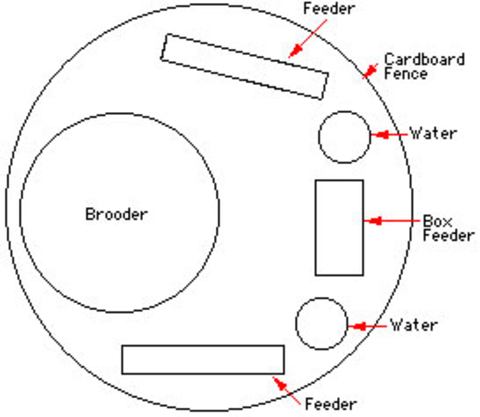Quick facts
-
Small flocks require relatively minimal space. Chicks require ½ square foot of space each. Mature birds require up to 2 ½ square feet of space each.
-
Always thoroughly clean the poultry house before introducing new chicks or pullets.
-
One 250 watt infrared lamp is generally sufficient for heating 80 chicks with an average brooder house temperature of 50 F.
-
Complete feeds from the local feed store are a good option for small flock owners.
-
Practice good biosecurity to keep your birds healthy.
Selecting chicks and pullets
Under proper care, healthy, well-bred chicks make for good layers. Selecting the right type of chick is key to efficient production. Small-bodied commercial White Leghorns that produce a lot of eggs at a low cost are the best layer hens. Some commercial brown egg-laying chickens lay nearly as well as White Leghorns.
If you are interested in producing eggs and meat, consider raising some good egg-type pullets and some broiler crosses for meat, rather than trying to use a dual-purpose breed that isn't best for either purpose. Pullets refer to young chickens that are less than one year of age.
Order sexed pullet chicks when purchasing layers. You don’t need males in a layer flock unless you want fertile eggs for hatching and most city ordinances for backyard chickens prohibit roosters. Commercial hatcheries and jobbers can provide healthy chicks or pullets for layer flocks.
It's best to delay the sexual maturity of pullets to permit better body growth before they begin egg production. An increase in day length encourages early sexual maturity of the pullet. Chicks hatched between April and August can be exposed to the natural day length because the day length is decreasing during the latter part of the growth period. These birds will respond favorably to increased light stimulation when they are physically ready to come into production.
Producers with small flocks should consider starting chicks after March, since less heat will be required to brood them. Brooding is the process of raising chicks, which includes keeping their body temperatures warm. To maintain the chicks’ body temperature, flock owners use warming houses called brooders.
Consider purchasing started pullets. Evaluate the cost of raising a started pullet yourself so you can compare it to your dealer’s prices. Here are some tips and tricks to help you calculate costs.
-
Multiply your chick cost by 1.1 to allow for possible death or culling.
-
From hatch to 20 weeks-old.
-
Leghorn pullets will eat 16 to 18 pounds per bird.
-
Mature birds will eat from 20 to 22 pounds per bird.
-
-
Assume equipment costs will depreciate over a 10-year period and housing costs over a 20-year period.
-
Include costs for litter, heat for brooding, lights, medication, etc.
-
Allow for any payments made for labor to care for the flock.
-
Convert your figure to a per-pullet basis for comparison.
Housing
Late spring and summer housing needs for brooding and rearing chicks and pullets are minimal. You can use any small building that meets the floor space needs of your chicks and pullets. After brooding, you can raise pullets in a fenced range or yard with a covered shelter for protection.
You can buy brooding, feeding and watering equipment from local feed and farm supply outfits. Some of the equipment you can build yourself. You can also check with local farmers for used equipment. Remember to always clean and disinfect any equipment before introducing the birds.
You may use roosts for pullets over 6 weeks of age. A roost is a perch that birds use to rest on at night. Use rounded, 2-inch, non-metal materials placed 12 to 15 inches apart. You can slant the roosting rack from the floor to about 24 inches high on the wall. You could also place it on a screened platform over a dropping pit. Allow 6 linear inches of roosting space for pullets.
Each chick needs ½ square foot of brooder house space from 1 day to 6 weeks of age.
Each Leghorn pullet needs 1½ to 2 square feet of floor space when confined during the growing period (6 to 15 weeks of age).
Each mature pullet needs 2 to 2 ½ square feet of floor space when confined during the growing period.
Thoroughly clean and disinfect the house and equipment before starting chicks. For used houses,
Remove litter, manure, dust and cobwebs from the house.
Wash the house using pressurized water.
Scrub and scrape all organic matter from the building and equipment surfaces.
Disinfect the building and equipment using an appropriate disinfectant.
Make sure to follow the directions on the manufacturer’s label.
Dry and air out the building.
Place 2 to 4 inches of wood shavings, straw or other litter material on the floor.
Place a cardboard fence around the brooding area to confine the chickens to the heat source for the first week.
Brooders are warming houses used to maintain the body temperatures of young birds. There are numerous heat sources you can use to warm the brooder including: infrared lamps, simple light bulbs or small electric elements.
Heat sources
Infrared lamps
Infrared lamps are a good heat source for brooding chicks. Use porcelain sockets approved for infrared lamps. Suspend the lamps at least 15 inches from the litter using a chain or wire (not the electric cord).
One 250 watt infrared lamp is generally sufficient for heating 80 chicks with an average brooder house temperature of 50 F. You can add one chick to this estimate for every degree over 50 F. It’s best to provide more than one lamp. This will make sure the chicks are with heat if one lamp burns out.
You can supply more heat by lowering the lamps to 15 inches above the litter or by using a higher-wattage lamp. You can reduce the heat by turning off some lamps, using smaller lamps or raising the lamp to 24 inches above the litter. Always base chick comfort on their body temperature, not the air temperature.
Other heating methods
You can purchase small brooders with electric heating elements.
You can also use a simple light bulb brooder similar to the one shown. You can simply change the bulb size in this unit to adjust the temperature.
Most of the larger brooders use gas or oil as fuel to more adequately supply heat.
Monitoring temperature
When using a brooder, start the chicks at 90 to 95 F. Make sure to take this temperature 2 inches off the floor, under the edge of the hover. Reduce the temperature by 5 F per week until the chicks no longer need supplemental heat.
You can watch the chicks to gauge their comfort level. If the chicks crowd together they need more heat. If the chicks move away from the heat source, they’re too hot. Allow 7 to 10 square inches of space under the brooder for each chick.
Start the brooder the day before the chicks arrive and adjust it to the proper temperature.
Feeding
Complete feeds from the local feed store are a good option for small flock owners. Farms that have good mixing facilities for other livestock can use local grains mixed with the proper commercial concentrate. Follow the directions provided by your local feed supplier.
A starter mash is generally fed for the first 6 to 8 weeks. Place the feed on chick box lids or trays for the first few days. Make sure the chicks have water as soon as they arrive. Provide 1 linear inch of feeder space per chick at the hoppers at first. You can increase the space to 2 inches once the chicks are 2 weeks old.
After 8 weeks of age, pullets are then given a grower or developer mash. You can then increase the feeder space to 3 to 4 inches per growing pullet. Once the pullets start laying (about 20 weeks of age) you can start the birds on a laying mash.
A hanging tube-type feeder 15 inches in diameter will feed about 30 birds. The birds will waste less feed if you fill the hoppers half full and adjust the feeder height or size to meet the birds’ size. You should have at least three sizes of hoppers to use for growing birds.
A yard or range can supplement pullet diets with green feed. Make sure chicks or pullets have chick- or pullet- sized grit available at the appropriate age. Try to keep your growing pullets within body-weight guidelines provided by the breeder.
Water
Provide a one-gallon water fountain per 50 chicks during the first 2 weeks. Increase the number or size of waterers from 2 to 10 weeks to provide 40 inches of watering space per 100 birds or 1 gallon capacity per 10 birds if using fountains.
Use a platform under waterers to avoid wet litter. Automatic waterers can save you labor, even with small flocks. Make sure chicks and pullets always have access to fresh, clean water.
Keeping the birds healthy
Isolate your birds
Separate your birds from other flocks, pets and wildlife.
Limit visitors from entering your poultry house and yard.
Keep your flock’s area free of rodents.
Use screens to keep wild birds out of the poultry house.
Control parasites
Rotate yard and range areas so that birds aren’t on the same ground each year.
Routinely clean your flock’s housing area.
Use a low-level coccidiostat drug in the feed during the brooding and growing period.
Occasionally check birds for lice and mites.
Have a vaccination program
Obtain chicks or pullets that are from Pullorum-typhoid clean stock.
Use a vaccination program for Newcastle disease and bronchitis, especially if there are other poultry flocks in the area.
Have chicks vaccinated at the hatchery for Marek’s disease.
A local veterinarian, or county Extension educator can assist you with flock health and other management problems or will direct you to a competent source of help.
Separate and care for birds by their age as much as possible.
Care for the younger birds first.
Routinely clean the house
Clean waterers daily and periodically wash them with a sanitizing solution.
Keep litter in good condition and remove caked and wet spots.
Add fresh litter as needed.
Provide good ventilation to keep out moisture and prevent ammonia build-up in the house.
Preventing cannibalism
Cannibalism often occurs in growing and laying flocks and is hard to control once it starts. The following factors can play a role in cannibalism.
Crowding
Nutrient deficiencies
Poor ventilation
Too little drinking or eating space
Too much light
Idleness
The appearance of blood on injured birds
Proper care can often control most of these factors. You can use a pick-paste remedy in small flocks if the problem hasn’t gotten out of hand. Beak trimming provides a permanent solution. Many hatcheries will beak-trim chicks at one day-of-age, if you request. Birds can be beak- trimmed at any age if done properly, but it should be avoided at times of stress or when pullets are coming into production.
Reviewed in 2018



